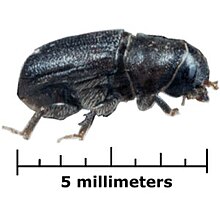
Back خنفساء الصنوبر الجبليه ARZ Dendroctonus ponderosae CEB Bergkiefernkäfer German Dendroctonus ponderosae Spanish Vuoristoniluri Finnish Dendroctonus ponderosae French Dendroctonus ponderosae Galician アメリカマツノキクイムシ Japanese Dendroctonus ponderosae NN Mountain pine beetle SIMPLE
| Mountain pine beetle | |
|---|---|

| |
| Adult | |
| Scientific classification | |
| Domain: | Eukaryota |
| Kingdom: | Animalia |
| Phylum: | Arthropoda |
| Class: | Insecta |
| Order: | Coleoptera |
| Infraorder: | Cucujiformia |
| Family: | Curculionidae |
| Genus: | Dendroctonus |
| Species: | D. ponderosae
|
| Binomial name | |
| Dendroctonus ponderosae (Hopkins, 1902)
| |
The mountain pine beetle (Dendroctonus ponderosae) is a species of bark beetle native to the forests of western North America from Mexico to central British Columbia. It has a hard black exoskeleton, and measures approximately 5 millimetres (1⁄4 in), about the size of a grain of rice.
In western North America, an outbreak of the beetle and its microbial associates affected wide areas of lodgepole pine forest, including more than 160,000 km2 (40 million acres) of forest in British Columbia.[1] The outbreak in the Rocky Mountain National Park in Colorado began in 1996 and has caused the destruction of millions of acres/hectares of ponderosa and lodgepole pine trees. At the peak of the outbreak in 2009, over 16,000 km2 (4.0 million acres) were affected.[2] The outbreak then declined due to better environmental conditions and the fact that many vulnerable trees had been already destroyed.[2][3]
Mountain pine beetles inhabit ponderosa, whitebark, lodgepole, Scots, jack,[4] limber, Rocky Mountain bristlecone,[5] and Great Basin bristlecone[6] pine trees. Normally, these insects play an important role in the life of a forest, attacking old or weakened trees, and speeding development of a younger forest. However, unusually hot, dry summers and mild winters in 2004–2007 throughout the United States and Canada, along with forests filled with mature lodgepole pine, led to an unprecedented epidemic.[7]
The outbreak may have been the largest forest insect blight seen in North America since European colonization.[8] Monocultural replanting, and a century of forest fire suppression have contributed to the size and severity of the outbreak, and the outbreak itself may, with similar infestations, have significant effects on the capability of northern forests to remove greenhouse gases (such as CO2) from the atmosphere.[9]
Because of its impact on forestry, the transcriptome[10] and the genome[11] of the beetle have been sequenced. It was the second beetle genome to be sequenced.
- ^ Irvin, Doyle (2017-02-15). "Blisters, Beetles and British Columbia: Global ReLeaf in Canada". American Forests Magazine. Archived from the original on 2021-07-11. Retrieved 2021-09-09.
- ^ a b "Bob Ward: Colorado Wildfires Are Linked to Global Warming". Huffingtonpost.com. 2013-06-19. Retrieved 2014-02-14.
- ^ "Broad-level Reconstruction of Mountain Pine Beetle Outbreaks from 1999-2015 across the Northern Region" (PDF). Fs.usda.gov. December 2019. Retrieved 2022-03-23.
- ^ Erbilgin, Nadir; Ma, Cary; Whitehouse, Caroline; Shan, Bin; Najar, Ahmed; Evenden, Maya (30 October 2013). "Chemical similarity between historical and novel host plants promotes range and host expansion of the mountain pine beetle in a naïve host ecosystem". New Phytologist. 201 (3): 940–50. doi:10.1111/nph.12573. PMID 24400902.
- ^ Bentz, Barbara J.; Hansen, E. Matthew; Vandygriff, James C.; Stephens, S. Sky; Soderberg, David (2021). "Rocky Mountain bristlecone pine (Pinus aristata) is a confirmed host to mountain pine beetle (Dendroctonus ponderosae)". Western North American Naturalist. 81. doi:10.3398/064.081.0102. S2CID 235324443. Retrieved 9 September 2022.
- ^ Bentz, Barbara J.; Millar, Constance I.; Vandygriff, James C.; Hansen, Earl M. (1 April 2022). "Great Basin bristlecone pine mortality: Causal factors and management implications". Forest Ecology and Management. 509: 120099. doi:10.1016/j.foreco.2022.120099. S2CID 246982193.
- ^ "The mountain pine beetle, Dendroctonus ponderosae, is a small insect, less than a centimetre long, which lives most of its life under the bark of pine trees, including lodgepole, ponderosa and western white pine". Archived from the original on 11 August 2010. Retrieved 2022-03-23.
- ^ Petit, Charles (2007-01-30). "In the Rockies, Pines Die and Bears Feel It". The New York Times. Retrieved 2009-02-09.
- ^ Kurz, WA; Dymond, CC; Stinson, G; et al. (2008-04-24). "Mountain pine beetle and forest carbon feedback to climate change". Nature. 452 (7190): 987–990. Bibcode:2008Natur.452..987K. doi:10.1038/nature06777. PMID 18432244. S2CID 205212545.
- ^ Keeling, Christopher I.; Henderson, Hannah; Li, Maria; Yuen, Mack; Clark, Erin L.; Fraser, Jordie D.; Huber, Dezene P.W.; Liao, Nancy Y.; Roderick Docking, T.; Birol, Inanc; Chan, Simon K.; Taylor, Greg A.; Palmquist, Diana; Jones, Steven J.M.; Bohlmann, Joerg (2012-08-31). "Transcriptome and full-length cDNA resources for the mountain pine beetle, Dendroctonus ponderosae Hopkins, a major insect pest of pine forests". Insect Biochemistry and Molecular Biology. 42 (8): 525–36. doi:10.1016/j.ibmb.2012.03.010. PMID 22516182.
- ^ Keeling, Christopher I; Yuen, Macaire MS; Liao, Nancy Y; Roderick Docking, T; Chan, Simon K; et al. (2013). "Draft genome of the mountain pine beetle, Dendroctonus ponderosae Hopkins, a major forest pest". Genome Biology. 14 (3): R27. doi:10.1186/gb-2013-14-3-r27. PMC 4053930. PMID 23537049.
© MMXXIII Rich X Search. We shall prevail. All rights reserved. Rich X Search